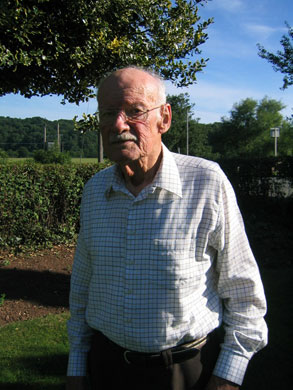 KNIGHTWICK PRACTICE (Photo - Tony Parsons - My Mentor and Wonderful Friend) KNIGHTWICK PRACTICE (Photo - Tony Parsons - My Mentor and Wonderful Friend)
In its history of 105 years Knightwick practice has seen only eight doctors. Its attraction is quite obvious but was expressed most clearly in Dr. Parsons’ own words - “Fishing, ornithology, good country, pleasant practice, and a nice part of the world to live. I knew what I wanted and I’ve been quite content”.
Dr. Jim Greensaw obviously recognized these attractions when he founded the practice in 1888. As the brother of the Great Witley doctor he recognized the need for another practice south of the Martley-Tenbury road, and a practice near the Sunningdale Sanatorium seemed ideal. Few remember the doctor now, but a particular memory of’ him was always held by a local woman, Emily Ruth Garnise. One day, as a young girl around 1905, she was asked by Dr. Greensaw to hold his horse for him for tuppence whilst he attended a patient on Ankerdine Hill. Emily grew up to always remember the incident - and the fact that she was never paid her promised tuppence
In 1907 Dr. Greensaw was replaced by Dr. English. He remained in Knightwick until 1918 when he was followed by Dr. Fry. After only 18 months he was replaced by Dr. Roger Clarke who was to remain in Woodford House for the next 41 years.
Despite his rather sharp, blunt manner Dr. Clarke was a popular man and was very keen on butterflies. When he first arrived in 1921 he stayed with Dr. Wells and Dr. Beck in Bromyard, using Raymond Jones’ dental surgery as their surgery. After Dr. Beck died of tuberculosis, a year or two after his arrival, Dr. Clarke fell out with the Bromyard doctors and decided to carry on alone in Knightwick. Meanwhile, the Bromyard doctors felt that Knightwick was their practice, and kept trying to take Knightwick patients back. The reverse, naturally, did not happens
Dr. Charles Parsons joined the practice in 1952, overlapping with Dr. Clarke for 9 years until he retired in 1961. It is astonishing to realize that the two doctors have between them clocked up over seventy years of looking after the health of the 100 square mile practice. During their time they have seen the significant changes produced by the introduction of penicillin in the 1940’s. For example, a pneumonia patient would have been seen 10-15 times pre-1940. Now he would be seen just once and given a shot of penicillin. As the work of’ the doctors has become less intense in this way, it has also become less practical. Midwives were first used in the practice in 1926, and Dr. Parsons was still delivering babies until, about 1970 when hospital confinements were introduced. The earlier doctors were also inevitably required to do far more minor surgery.
The largest change to the practice during Dr. Parsons’ time was the moving of the surgery out of Woodford House and into its present site in 1974. Since Dr. Greensaw moved in at the turn of the century Woodford House had acted as both surgery and dispensary and consequently was home to five doctors. In 1975 a patch of land was bought in Clifton-on-Teme and an extra surgery was built for Clifton patients. In 1966 Cameron’s New Charter was introduced, allowing 70% rebate of staff wages. This enables the practice to employ two full-time or four part-time staff per doctor. Hence, when Dr. Tony Collis joined the practice in 1978, eight par-time staff could be employed for the first time.
These changes have had a dramatic, but highly beneficial effect on the practice. In the past, drugs could only be picked up at specific times, the doctor could not always be contacted and surgery hours were far more limited. The practice now has an “open all hours” approach. Patients would certainly notice the difference if they were to be without today’s band of dedicated and efficient staff !
With the moving of the surgery to its present site in 1974, Dr. Collis’s skills and enthusiasm for carpentry and electronics proved to be invaluable. After building and fitting all the cupboards and shelves in the practice he installed the telephone, answer-phone, the central heating system, wired up all the electrical system and repaired all the plumbing. Few patients realize that he even built his own examination couch!
The practice received another shake-up in the Spring of 1990 when the General Practitioners New Contract came into effect. With the introduction of target payments, more clinics and regular health checks the use of computers for, amongst other things, up-to-date searches became essential. Dr. Collis studied computer language, installed the computers, wrote the programmes, and, after much patience with Knightwick staff, now runs a very successful system.
The first female doctor in Knightwick was Dr. Lesley Hickman who arrived in 1986 to work part-time in the practice and she was replaced in the Autumn of 1987 by Dr. Anne Lewis.
In the summer of 1992 Dr. Parsons’ era was to end as he retired to a life of fishing and bird watching. Still living in Woodford House, he is never far away and his presence in Knightwick will inevitably be felt for many years ahead.
Dr. Parsons’ partnership was replaced by Dr. Anne Lewis and Dr. Andrew Bywater who are both now working half-time. The surgery is now preparing itself for more changes as it looks forward to some much needed extensions. After 105 years of history, Knightwick practice is thriving and seems more than ready to continue to do so in the years ahead.
|
©peh